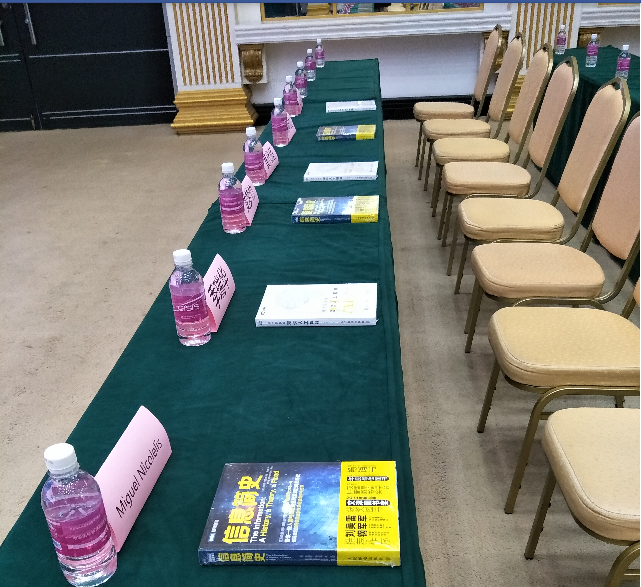本文仅用于学习和交流目的,不得用于商业目的。非商业转载请注明作译者、出处,并保留本文的原始链接:http://www.ituring.com.cn/art...
6月15日~6月18日,图灵作为技术图书出版先锋品牌,受邀参加了第十五届中国国际软件和信息服务交易会(中国软交会)。本届中国软交会以“新IT、新生态、新动能”为主题,汇聚了来自全球的业界精英和代表,全面展示了IT产业的新技术、新思维和新模式,分享了智能化在医疗、金融、服装等行业引起的改变,共同探讨了企业“智”造之路的务实方案。
作为受邀出版机构,图灵为参会人员带来了全新的“智慧阅读”体验,用科技和文化元素来打通IT人的圈层文化。“图灵访谈”作为媒体嘉宾,会议期间对重量级嘉宾米格尔·尼科莱利斯和李杰进行了访谈。
访谈嘉宾:
Miguel Nicolelis(米格尔·尼科莱利斯),美国杜克大学医学院神经生物学教授、法国科学院院士、巴西科学院院士、畅销书《脑机穿越》作者、2014年巴西世界杯“机械战甲”发明者。
他曾被美国科普杂志《科学美国人》评为全球最具影响力的20位科学家之一,其研究被《麻省理工科技评论》评为10大最具突破性的科技创新之一。
访谈实录:
决定投身“脑机接口”研究的原因是什么?
米格尔: 一开始,我只是想研究人脑是怎么工作的。这是主要的原因。随着技术的发展,我发现我们能用脑机接口来帮助患有各种疾病的病人。这给了我更大的动力来继续这方面的研究工作。
您做过很多非常棒的实验,哪一个最特别?
米格尔: 在外骨骼的帮助下,病人可以再次行走。失去双腿的病人在世界杯开幕式上可以再次踢足球。(这些对于我来说,都很特别。)我和他们每天都呆在一起,生活了8个月。站起来行走的那一刻对于他们每一个人来说,都是一个巨大的胜利,值得庆祝!
当Juliano在巴西世界杯开幕式上踢开一脚的时候,我就站在他身后的3米远。我跑向他,一起庆祝。这一刻值得所有人流泪。
“脑机接口”研究的最终目标是什么?
米格尔: 在医疗方面,目标是恢复病人失去的功能。其他方面的应用有远程控制机器人,把机器人派到对于人类来说太小、太远或是太危险的地方。如果能用人类大脑直接控制这些机器人,我们就能获得更多的灵活性和更好的移动性。
另一件事是,多人通过“大脑网”进行远程协作。
(图灵出版的《信息简史》《漫谈人工智能》受到“中国软交会”嘉宾的喜爱)
对下一代计算设备的展望是怎样的?对于人类来说,实现大脑控制计算程序的主要挑战是什么?
米格尔: 实际上,我认为未来将会看到大脑和计算机之间的连接,从而开发出新的计算设备。这是一场全面的革命,因为我们的大脑将会跟这些设备直接相连。我们不再需要打字,只通过思考就能和电脑互动。
最大的挑战是能够可靠地提取信号,并且计算机能够与大脑交互。这样我们可以得到一个非常高效的接口用于日常工作,比如处理手机、笔记本电脑和汽车。一旦完善了这个交互,我们将看到脑机接口对整个技术的巨大影响。
我们是否还需要穿戴一些东西来让大脑连接到数字应用?
米格尔: 是的,我们总是需要一些传感器来捕捉大脑的活动。没有这些传感器,就无法传输大脑的电信号。传感器要能够尽可能多地从大脑中获取信息,完善与数字平台交互的能力。对于动物来说,接口会植入大脑。但是对于人类来说,我们会研究一种类似帽子的东西。因为不会植入任何东西,所以对人类来说不会有危险。
这些接口是否有助于治疗基因缺陷引起的疾病?
米格尔: 不,这并不针对基因缺失引起的疾病。你必须意识到世界上有近10亿的人患有脑功能紊乱的疾病。如果我们把所有患有大脑功能紊乱的人放在一起,这几乎就是一个中国的人口。
大多数患有脑功能障碍的病人与基因方面并没有关系。它们大部分来自脊髓损伤、帕金森和阿尔茨海默病症。我们需要对这将近10亿的病人进行治疗,我认为这项技术会有所帮助。
您对“不可能”的理解是什么?
米格尔: 当我还是个孩子的时候,祖母告诉我,“不可能的事就是还没有人花费足够的时间去做的可能的事”。我十分相信这一点。我的祖母是一个很有智慧的女人。我认为成为一名科学家与她对我的影响有着很大的关系。她教会了我如何思考大事情。
随着研究发展,你的新发现是什么?
米格尔: 事实上,我正在写一本新书,因为有很多新的想法出现。我在书中提到了一点,而且我认为现在很有必要讲的一点是,有越来越多的证据表明我们的大脑远比计算机优越。人工智能不会征服人类的大脑。这就是我决定写一本新书的原因。
What reasons are there making you dedicate yourself to brain-machine interfaces?
First, I want to investigate how the brain works. That's the main reason. As technology develops, I realize that we could use that to treat patients suffering from various diseases. It gives extra motivation to continue this approach.
You've done lots of fantastic experiments. Which one do you think is most special?
The patient with exoskeleton could walk again and the patient who has lost legs could kick again on the opening ceremony of world cup. I lived with these patients every day for 8 months. The moment they were up and walk is a big victory and celebration for each one of them. That's the most profound thing I have done, I think.
When Juliano kicked the ball on the ceremony, I was three meters behind him. After that kicking, I run to him for celebration. At that time, I almost cried because it's like a miracle.
What's the ultimate goal for brain-machine interfaces?
On the medical front, the goal is to restore functions to patients who have lost them. There will be other applications in controlling robots in places where it's too small, too far or too dangerous. If we can control robots directly with our brain, we could gain more flexibility and mobility.
The other thing is that multiple people could collaborate at distance through brain net.
What's your outlook for next generation computational devices? What's the main challenge for humans to realize brain control of computational Apps?
I actually think that the future will see the links between brains and computers to develop new computational devices. It's a total revolution in the way we talk about computers, because our brain is going to be directly linked to these devices. We don't need to type anymore, if we can basically interact with computers just by thinking.
The biggest challenge is to be able to extract signals reliably and that computers are able to interact with the brain. So we get a very efficient interface that can be used for routine tasks, like dealing with laptops, cars and cellphones. Once we perfect this link, we'll see tremendous impacts on technology.
Do we still need some kind of things to wear so as to connect brains to digital Apps?
Yes, we always need some sensors to capture brain activities. Without that, we couldn't transmit the electrical signals from our brains. We really need to develop the sensors to the point that we could get as much as possible from the brain to interact with digital platforms.
For animals, we implant. For human beings, what we're developing is something like a cap. You don't need to implant anything. That's the reason why it's not dangerous.
Would the interfaces be helpful for diseases resulted from genetic defects?
No, that's not for genetic diseases. You have to realize that there're almost one billion people in the world with brain disorder. If we put all the brain-disordered people together, it's almost one China of patients.
Most of the patients with brain disorder have nothing to do with genetic reasons. They come from lesions of spinal cord, Parkinson and Alzheimer's disease. So we need treatments for these almost one billion people. I think the technology will help.
What's your understanding of "impossibility"?
My grandmother told me when I was a kid that “the impossible is just the possible that nobody put time enough to make”. I believe in that. She was a very intellectual woman. I think to become a scientist has strong relationships with her influences on me. She taught me how to think big things.
As your research moves on, what's your new finding?
In fact, I'm finishing a new book, because there are so many new ideas coming out. One thing I've talked a little bit in the book and I think it's very important to say now is that there is more and more evident showing our brains are far superior than computers. AI will not overcome the human brain. That's the reason why I decide to write a new book.



**粗体** _斜体_ [链接](http://example.com) `代码` - 列表 > 引用。你还可以使用@来通知其他用户。